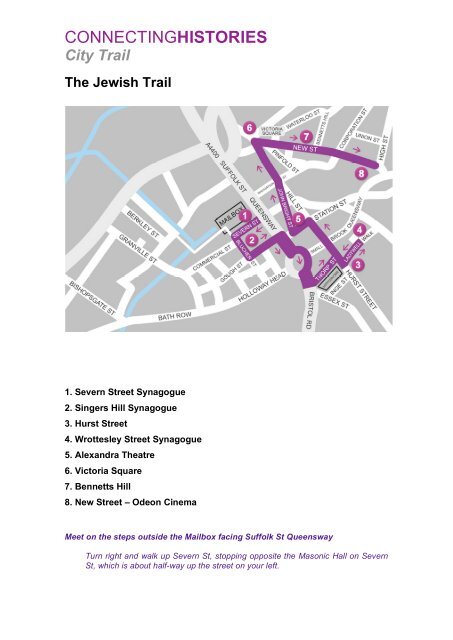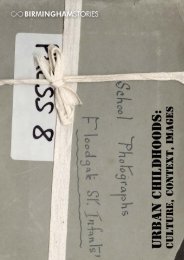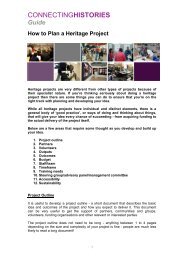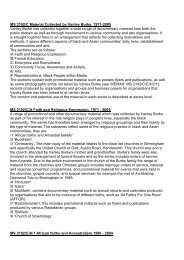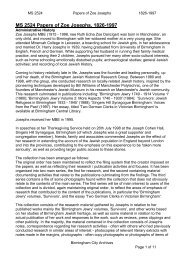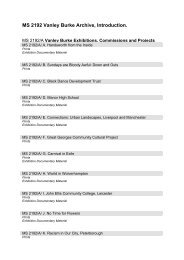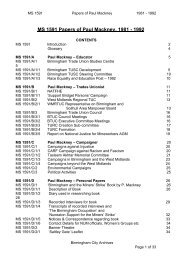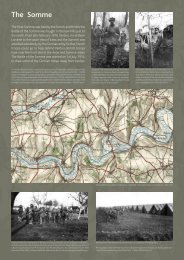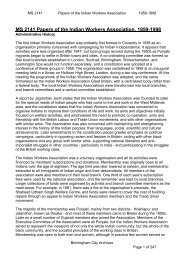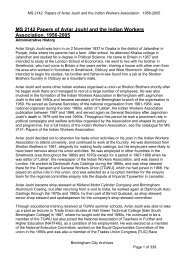download this trail - Connecting Histories
download this trail - Connecting Histories
download this trail - Connecting Histories
You also want an ePaper? Increase the reach of your titles
YUMPU automatically turns print PDFs into web optimized ePapers that Google loves.
CONNECTINGHISTORIES<br />
City Trail<br />
The Jewish Trail<br />
1. Severn Street Synagogue<br />
2. Singers Hill Synagogue<br />
3. Hurst Street<br />
4. Wrottesley Street Synagogue<br />
5. Alexandra Theatre<br />
6. Victoria Square<br />
7. Bennetts Hill<br />
8. New Street – Odeon Cinema<br />
Meet on the steps outside the Mailbox facing Suffolk St Queensway<br />
Turn right and walk up Severn St, stopping opposite the Masonic Hall on Severn<br />
St, which is about half-way up the street on your left.
1. Severn St Synagogue<br />
The Jewish community was expelled from England at the end of the 13th century and<br />
was not readmitted until 1656. The earliest evidence for a Jewish presence in<br />
Birmingham comes from the 18th century: there are some Jewish names in trade<br />
directories and by 1766, the community had bought land for a cemetery.<br />
The oldest surviving synagogues in Birmingham can be found in the old Jewish quarter<br />
around Hurst St and Holloway Head. Early descriptions of Birmingham's Jews say that<br />
they were artisans: pencil-makers, button and buckle makers, watchmakers and tailors;<br />
or pedlars who travelled around the countryside outside the city selling jewellery and<br />
metalwork. On Fridays, they would come back home to celebrate the Jewish holy day,<br />
the Sabbath, which begins on Friday evening and lasts until Saturday evening.<br />
Their synagogue, in a damp and poor area of the city called 'The Froggery' is described<br />
by the Birmingham historian William Hutton, writing in 1780: ‘In the synagogue, situated<br />
in the Froggery, they still preserve the faint resemblance of their ancient worship. Their<br />
whole appurtenances being no more than the drooping ensigns of poverty. The place is<br />
rather small, but tolerably well filled where there appears less decorum than in the<br />
Christian churches.’ He also says that ‘their society is almost entirely confined to<br />
themselves, except in the commercial line’. No trace of the Froggery and its buildings<br />
now survives; the area was destroyed to make way for New Street Station.<br />
The oldest surviving synagogue building in Birmingham is the Severn St synagogue,<br />
which was dedicated on 23 September 1809 and enlarged in 1827. In 1871, during<br />
alterations to the building, the original foundation stone was discovered. A plaque<br />
attached to it listed the names of the five principal men of the Congregation: David, son<br />
of Solomon, Judah, son of Coleman, Solomon, son of Mordecai, Jacob, son of Samuel,<br />
and Moses, son of Lyon.<br />
The first Hebrew School was held in the vestry of <strong>this</strong> building between 1840 and 1843,<br />
until the Birmingham Hebrew Congregation was able to raise enough money for a<br />
separate building in Lower Hurst St.<br />
Walk up the hill and turn left onto Blucher St. Singers Hill Synagogue is the<br />
Victorian red-brick building on your left, behind a fence of metal railings.<br />
2. Singers Hill Synagogue<br />
In 1856, the Congregation sold Severn St Synagogue, and moved up the hill to the<br />
grander surroundings of Singers Hill Synagogue. Singers Hill was designed by the<br />
architect Henry Yeoville Thomason, who went on to design the Council House. Shortly<br />
after it was finished, the synagogue was described in the local press as ‘a glory to the<br />
community and an ornament to the town’. A letter written at the time of the opening of<br />
the synagogue describes the consecration ceremony like <strong>this</strong>: ‘I should judge there<br />
were about 1500 people in the buildings a little after one o'clock, a beautiful canopy<br />
and four supporting gentlemen were at the entrance of the Shool [synagogue] door<br />
when the Chief Rabbi said: "Open unto me the Gates of Righteousness, I will go unto<br />
them and I will praise the Lord" (Psalm 118, Verse 19). Then the Wardens and<br />
gentlemen made a procession seven times round the altar, each bearing a scroll of the<br />
Law, the organ playing most solemnly and the choristers singing. Heavenly, not a<br />
whisper was heard. Then Dr Adler from the pulpit gave a beautiful lecture. His text was<br />
from the psalms, I will dwell in the house of the Lord for ever.’<br />
2
The Birmingham Hebrew School met in a room behind the synagogue from 1856 until<br />
the 1930s, and acquired a second school building round the corner from the<br />
synagogue in 1899, now Trefoil House. In the 1930s, the Congregation raised money<br />
for a purpose-built school in St Luke's Rd and <strong>this</strong> building was sold. The old<br />
schoolroom is now part of the Joseph Cohen Hall, which is still used for events.<br />
Continue down Blucher St. Turn left down Gough St, then right along Suffolk St<br />
Queensway. Cross over the pedestrian crossing on the roundabout and turn into<br />
Smallbrook Queensway. There is a set of traffic lights and a pedestrian crossing<br />
on your right, in front of the Radisson Hotel. Use <strong>this</strong> pedestrian crossing, then<br />
turn right, passing Scala House (don't go into the subway). Take the first left onto<br />
Thorp St and turn right onto Hurst St. Stop in front of the Hippodrome Theatre.<br />
3. Hurst Street<br />
Hurst St was well-known as a Jewish street in the 19th and 20th centuries and there<br />
have been many Jewish buildings here at various times including two synagogues, a<br />
mikveh (ritual immersion pool), a school, and many shops and private homes.<br />
Kelly's directory (the 19th century equivalent of today's Yellow Pages) reveals several<br />
possible Jewish names and occupations in the buildings on Hurst St in 1890:<br />
East side<br />
4 Joseph King, watchmaker<br />
8 Confidential Loan and Advance Company (Samuel Edward Marks, manager)<br />
13 Hyman Lyons, pawnbroker<br />
30 Jacob Moore, bird dealer<br />
35 1/2 Jacob Harris, slipper maker<br />
47 Fanny Raphael, second hand clothes dealer<br />
West side<br />
62 Marcus Myers, glazier<br />
63 1/2 Henry Samuel Ansell, watch case maker<br />
64 Joseph Hyman Carter, basket maker<br />
73 Solomon Harris, second hand clothes dealer<br />
81 Lawrence Hyman Davis, tobacconist<br />
89 Isaac Greenberg, tailor<br />
The first Hebrew School building was in Lower Hurst St. It was set up by a group of<br />
prominent local Jews, who thought that 'it was a pity that a school was not in existence<br />
for the Hebrew children, who seemed to be wandering about entirely at the mercy of<br />
circumstances, without any means of having their ideas properly formed'. When the<br />
school opened in 1843, there was an elaborate opening ceremony, which was attended<br />
by many important people in the town and was followed by a celebration dinner. The<br />
school moved to a building next to the new Singers Hill synagogue in 1856.<br />
A Jewish family lived in one of the Back to Back houses on Inge St, now owned by the<br />
National Trust. Their house has been furnished to show how it might have looked on a<br />
Sabbath evening in the 1850s.<br />
Turn right down Ladywell Walk, cross over the road, and stop outside the Chung<br />
Ying Chinese restaurant.<br />
3
4. Wrottesley St<br />
The Chung Ying restaurant on the corner of Wrottesley St and Ladywell Walk has been<br />
used as a synagogue twice: between 1853 and 1856, and from 1901 and 1928. It is the<br />
ancestor of the Central Synagogue on the Pershore Road.<br />
In 1853, a group of about ninety members left Singers Hill Synagogue complaining<br />
about the 'supremacy of money', that 'poor Jews worshipped on sufferance', and about<br />
the 'dictatorial airs' of David Barnett, one of the leading members of the Congregation.<br />
They held services in Wrottesley St for three years, but were persuaded to return to<br />
Singers Hill in 1856 when the system for collecting membership payments was revised.<br />
The second split in the Congregation, which happened at the end of the19th century,<br />
was permanent. At <strong>this</strong> time, many Jews were coming to Birmingham from Central and<br />
Eastern Europe. They found Singers Hill, which was known as 'the Englische schule'<br />
(synagogue) very different from the synagogues they were used to, and around 1900, a<br />
small group left Singers Hill and set up the Wrottesley St Beth Hamedrash, which<br />
become known as 'the immigrants' synagogue'.<br />
The governing council of Singers Hill gave financial support to the synagogue, but for<br />
many years, the Beth Hamedrash was required to apply to them annually for<br />
permission to hold services and they were not allowed to employ a Mohel (who<br />
performs circumcisions) or a Schohet (kosher butcher).<br />
Walk back up Ladywell Walk, turn right onto Hurst St and walk back to<br />
Smallbrook Queensway. Use the pedestrian crossing and walk up Hill St. Cross<br />
over to the left hand side of the street at the zebra crossing by the Crown pub,<br />
then turn into Station St, which bends round to the right and turns into John Bright<br />
St. Stop opposite the back entrance to the Alexandra Theatre on John Bright St.<br />
5. Alexandra Theatre<br />
The Alexandra Theatre, one of the most popular in the city, was bought by Leon<br />
Salberg in 1911. At first, the theatre presented reviews and dramas, but later, it formed<br />
its own repertory company which put on a different play every week, some presented<br />
twice nightly.<br />
‘Three thousand people booked weekly, week in, week out. People would give up their<br />
holidays for an Alex production, people married who met at the Alex.’<br />
The theatre building was remodelled in 1934 in order to compete with the newlyestablished<br />
picture houses. Leon Salberg made the Alex available to several different<br />
groups in the Jewish community. Scenery from the Alex was lent to the Jewish Arts<br />
Society for their shows; they also performed at the Alex during the 1920s. The<br />
schoolchildren of the Hebrew School visited the Alex every year for their annual treat.<br />
Leon Salberg was very active in the affairs of Singers Hill synagogue. One of his<br />
particular interests was the cemeteries: his son recalled that ‘he was responsible for<br />
the transformation of Witton Cemetery from a shambles...and every Sunday he went to<br />
some meeting connected with the synagogue or Jewish charities.’ After his death in<br />
1936, his son Derek managed the Alex. His book My Love Affair with a Theatre is<br />
available in Local Studies, Birmingham Central Library.<br />
Walk down John Bright St to the junction with Hill St. Walk up Hill St and bear<br />
right into Victoria Square. Stop near the Council House.<br />
4
6. Victoria Square<br />
As the centre of local government in Birmingham, Victoria Square is a good setting to<br />
talk about campaigns for Jewish civil rights.<br />
The first Jew to serve on the Birmingham Town Council was called David Barnett,<br />
elected in 1839. He was a prominent member of the Jewish community and active in<br />
local politics in the city, serving on the Board of the Queen Elizabeth Hospital, the<br />
Jewish Board of Guardians, and many of the Committees that managed the affairs of<br />
his synagogue. He was one of several members of the Congregation who set up the<br />
Birmingham Hebrew School. His election was an important moment in Birmingham's<br />
history. Town Councillors were required by law to swear an oath of allegiance 'on the<br />
true faith of a Christian'. David Barnett, as a Jew, could not take <strong>this</strong> oath. However,<br />
after some discussion, 'the Council allowed that Mr Barnett take the declaration<br />
conscientiously with the omission of the words, for his religion strictly commanded<br />
Israelites that wherever they might be, they were duty bound to support the<br />
establishment of that country.' Although David Barnett was elected in 1839, a bill<br />
permitting Jews to hold municipal office was not passed until 1845, and almost twenty<br />
years passed before, in 1858, Lionel de Rothschild became the first Jewish MP to take<br />
his seat in Parliament, swearing the oath "So help me, Jehovah".<br />
The Council House was designed by the Birmingham architect Henry Yeoville<br />
Thomason, who, earlier in his career had built Singers Hill Synagogue.<br />
Walk away from Victoria Square down New St and turn left on Bennetts Hill.<br />
Stop at no 11, on the left side of the street.<br />
7. Bennetts Hill<br />
10, Bennetts Hill was the home and business premises of David Barnett, who<br />
was a jewellery merchant. He lived there with his business partner Samuel<br />
Neustadt and their families. Some of the Victorian buildings on <strong>this</strong> street have<br />
disappeared, but you can still see a blue plaque marking the site of no 11 which<br />
was the birthplace of the artist Sir Edward Burne-Jones. When he was a child in<br />
the 1830s, the young Edward was close friends with the children next door; his<br />
mother's memoirs include descriptions of life in the Neustadt/Barnett household.<br />
‘The household was a Jewish one, and almost patriarchal in character; for the<br />
two partners of a firm of merchants established in Birmingham, Messrs.<br />
Neustadt and Barnett, had married two sisters, and both families including<br />
children, a widowed mother, and a maiden aunt, lived together under the same<br />
roof...They shared all their pleasures and amusements with [Edward], nor was<br />
he excluded even from their holy days and festivals. At the Feast of Purim he<br />
dressed up with the other children, and was so eager for the merry-making that<br />
when the day came round, he was always the first guest to arrive.’<br />
Bertram Silverston, who was Chairman of the Congregation's governing Council<br />
and a Trustee in the 1920s - 1940s, lived at 16 Bennetts Hill.<br />
Walk back down Bennetts Hill and turn left onto New Street. Walk down New<br />
Street looking for the Odeon cinema on your right and stop outside.<br />
5
8. New St Odeon Cinema<br />
The Odeon cinema chain, whose distinctive art deco sign is a familiar sight on<br />
most high streets, was created by Oscar Deutsch, who was born into a Jewish<br />
family from Balsall Heath in 1893.<br />
His cinema chain, which was famous for its innovative architecture and lavish<br />
interiors, brought a touch of luxury to all. It grew rapidly: there were 26 Odeons<br />
in 1933 and 250 in 1937. The word Odeon was said to stand for 'Oscar Deutsch<br />
Entertains Our Nation' and its sign was designed by the Birmingham firm<br />
Pearce Signs.<br />
Oscar Deutsch was the President of Singers Hill synagogue from 1932 until his<br />
death from cancer in 1941. During his term as President, the synagogue was<br />
extended, the Hebrew School was moved to a new site and new offices and a<br />
community hall were built, using the same architect who designed some of his<br />
most famous cinema buildings, Harry Weedon. He set up the Jewish<br />
Representative Council, which brought Birmingham synagogues together to<br />
assist Jewish refugees. There is a stained glass window in his memory in<br />
Singers Hill synagogue.<br />
This is the end of The Jewish Trail<br />
Compiled by Anna Riggs, 2006<br />
www.connectinghistories.org.uk<br />
6


